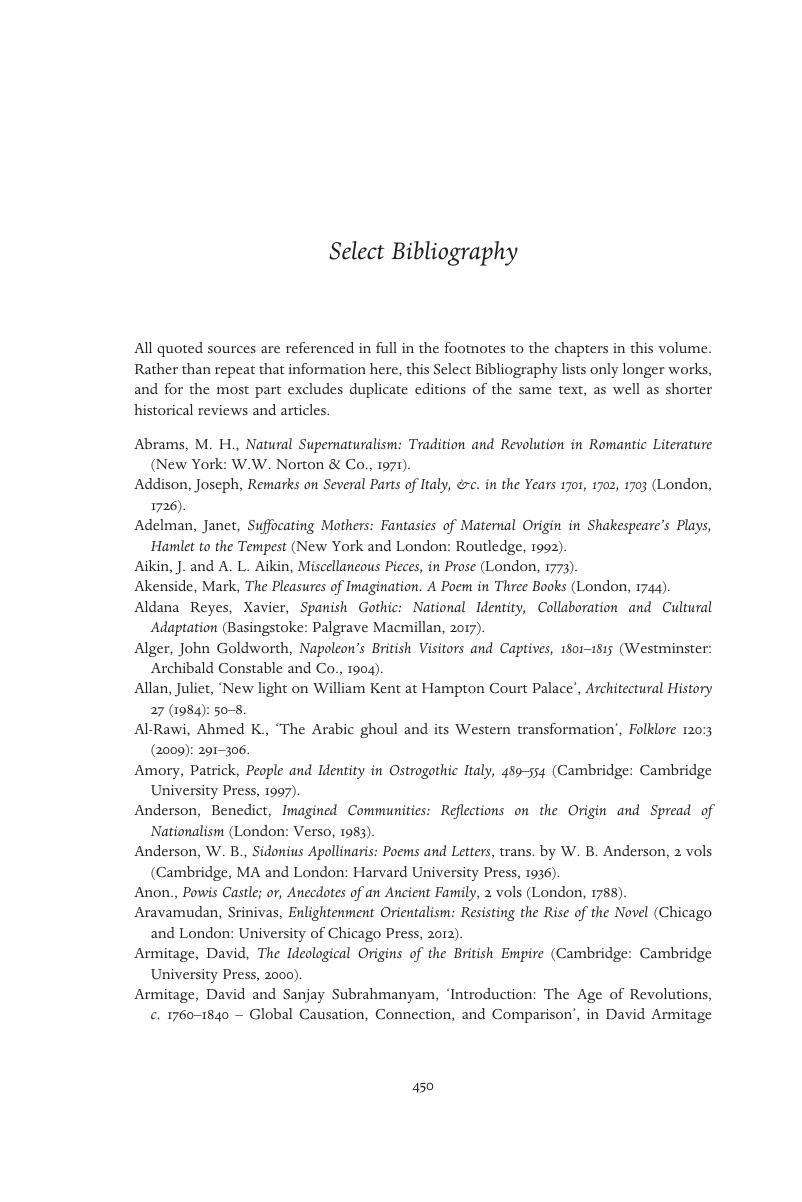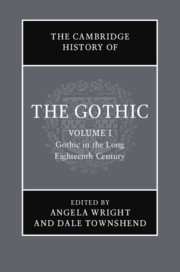Book contents
- The Cambridge History of the Gothic
- The Cambridge History of the Gothic
- The Cambridge History of the Gothic
- Copyright page
- Contents
- Illustrations and Captions for Volume I
- Notes on Contributors
- Acknowledgements
- Introduction: The Gothic in/and History
- 1.1 The Goths in Ancient History
- 1.2 The Term ‘Gothic’ in the Long Eighteenth Century, 1680‒1800
- 1.3 The Literary Gothic Before Horace Walpole’s The Castle of Otranto
- 1.4 Gothic Revival Architecture Before Horace Walpole’s Strawberry Hill
- 1.5 Horace Walpole and the Gothic
- 1.6 Shakespeare’s Gothic Transmigrations
- 1.7 Reassessing the Gothic/Classical Relationship
- 1.8 ‘A World of Bad Spirits’: The Terrors of Eighteenth-Century Empire
- 1.9 In Their Blood: The Eighteenth-Century Gothic Stage
- 1.10 Domestic Gothic Writing after Horace Walpole and before Ann Radcliffe
- 1.11 Early British Gothic and the American Revolution
- 1.12 Gothic and the French Revolution, 1789–1804
- 1.13 The Aesthetics of Terror and Horror: A Genealogy
- 1.14 Ann Radcliffe and Matthew Lewis
- 1.15 The Gothic Novel Beyond Radcliffe and Lewis
- 1.16 Oriental Gothic: Imperial-Commercial Nightmares from the Eighteenth Century to the Romantic Period
- 1.17 The German ‘School’ of Horrors: A Pharmacology of the Gothic
- 1.18 Gothic and the History of Sexuality
- 1.19 Gothic Art and Gothic Culture in the Romantic Era
- 1.20 Time in the Gothic
- Select Bibliography
- Index
- References
Select Bibliography
Published online by Cambridge University Press: 16 July 2020
- The Cambridge History of the Gothic
- The Cambridge History of the Gothic
- The Cambridge History of the Gothic
- Copyright page
- Contents
- Illustrations and Captions for Volume I
- Notes on Contributors
- Acknowledgements
- Introduction: The Gothic in/and History
- 1.1 The Goths in Ancient History
- 1.2 The Term ‘Gothic’ in the Long Eighteenth Century, 1680‒1800
- 1.3 The Literary Gothic Before Horace Walpole’s The Castle of Otranto
- 1.4 Gothic Revival Architecture Before Horace Walpole’s Strawberry Hill
- 1.5 Horace Walpole and the Gothic
- 1.6 Shakespeare’s Gothic Transmigrations
- 1.7 Reassessing the Gothic/Classical Relationship
- 1.8 ‘A World of Bad Spirits’: The Terrors of Eighteenth-Century Empire
- 1.9 In Their Blood: The Eighteenth-Century Gothic Stage
- 1.10 Domestic Gothic Writing after Horace Walpole and before Ann Radcliffe
- 1.11 Early British Gothic and the American Revolution
- 1.12 Gothic and the French Revolution, 1789–1804
- 1.13 The Aesthetics of Terror and Horror: A Genealogy
- 1.14 Ann Radcliffe and Matthew Lewis
- 1.15 The Gothic Novel Beyond Radcliffe and Lewis
- 1.16 Oriental Gothic: Imperial-Commercial Nightmares from the Eighteenth Century to the Romantic Period
- 1.17 The German ‘School’ of Horrors: A Pharmacology of the Gothic
- 1.18 Gothic and the History of Sexuality
- 1.19 Gothic Art and Gothic Culture in the Romantic Era
- 1.20 Time in the Gothic
- Select Bibliography
- Index
- References
Summary

- Type
- Chapter
- Information
- The Cambridge History of the GothicVolume 1: Gothic in the Long Eighteenth Century, pp. 450 - 483Publisher: Cambridge University PressPrint publication year: 2020



